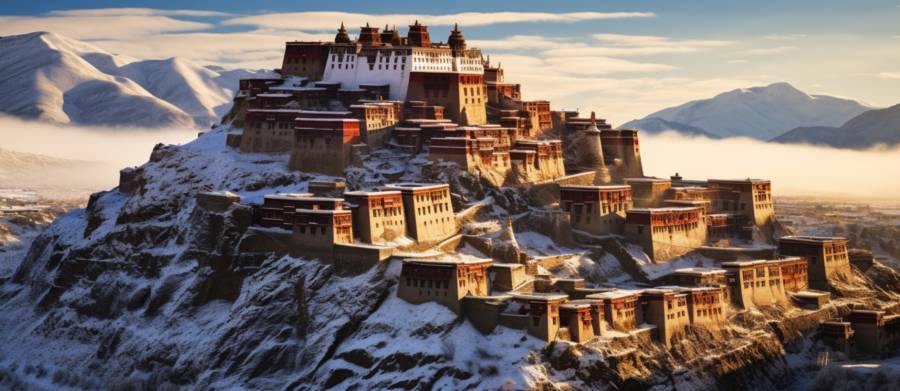Sakya Monastery: Tibet's Fortress of Ancient Scriptures

A Fortress Straight from a Kung Fu Movie
Imagine a scene from an epic Kung Fu movie where a monk singlehandedly defends an ancient fortress filled with priceless scriptures while using a combination of sacred martial arts and sacred texts. This is Sakya Monastery, a fortress of ancient scriptures in Tibet.Sakya Monastery is a treasure trove of ancient wisdom, nestled in the mountains of Tibet like a wise old hermit waiting to impart his knowledge to those who seek it. The monastery is like a physical embodiment of the line "Wherever you go, there you are." Because when you're in Sakya Monastery, you're not just in a place—you're in a state of mind, man.
Where is Sakya Monastery?
Well, I'm glad you asked. Sakya Monastery is located in the Tsang region of Tibet, which is a bit like asking "Where's Waldo?" but with more mountains and fewer candy-striped shirts. It's about 127 kilometers west of Shigatse, and if you have no idea where Shigatse is, don't worry, neither do I. We'll just call it "remote."Getting to Sakya Monastery is no easy feat. It involves a combination of planes, trains, automobiles, and possibly a yak or two. However, if you're serious about delving into the mysteries of ancient Tibet, it's worth the journey. Just be sure to pack some extra socks and maybe a Sherpa or two.
What's So Special About Sakya Monastery?
Sakya Monastery is not your average tourist destination. It's more like a journey into the heart of Tibetan Buddhism, a spiritual theme park where the rides are made of meditation and the rollercoasters are existential crises. The monastery was founded in 1073 and is the main temple of the Sakya sect of Tibetan Buddhism, which means it's kind of a big deal.Beneath the imposing grey stone walls of Sakya Monastery lies a treasure trove of ancient scriptures and artifacts. The monastery houses over 40,000 sacred texts, some of which date back to the 11th century. It's like the Library of Alexandria, but with fewer fires and more incense.
Can You Tell Me More About These Ancient Scriptures?
Boy, can I ever! The sacred texts housed in Sakya Monastery are written in a variety of languages, including Tibetan, Sanskrit, and Chinese. They cover a wide range of subjects, from philosophy and medicine to astronomy and art. It's like the most epic book club in the world, only with less chardonnay and more chanting monks.Some of the most famous texts found in Sakya Monastery include the Tibetan Buddhist Canon, which is kind of like their Bible, and the beautiful murals that adorn the walls, depicting scenes from Buddhist mythology and the lives of famous lamas (that's Tibetan for "gurus," not the spitting camelids).
What Else Can I See at Sakya Monastery?
Besides the ancient texts and stunning murals, Sakya Monastery has plenty more to offer the intrepid traveler. The monastery is home to a giant, gilded statue of the Buddha, as well as countless other statues and religious artifacts.One of the most interesting things about Sakya Monastery is the way it's designed. The layout of the monastery is said to represent the Buddhist cosmos, with the main temple symbolizing Mount Meru, the center of the universe in Buddhist cosmology. It's like a giant, stone, spiritual map, just waiting to guide you to enlightenment (or at least to the nearest bathroom).
OK, You've Convinced Me. How Do I Get to Sakya Monastery?
- First, you'll need to get yourself to Tibet, which can be a bit tricky due to the whole "autonomous region of China" thing. The easiest way is to fly into Lhasa, the capital of Tibet.
- Once you're in Lhasa, you can take a bus or hire a car to take you to Shigatse. Remember, it's about 127 kilometers from there, so take that into consideration when planning your trip.
- From Shigatse, you'll need to find transportation to Sakya Monastery. This can be a bit more challenging, as there's no direct bus route. Your best bet is to hire a car or join a tour group.
Article kindly provided by myfavouritehols.com
Latest Articles
- How to Plan Around Peak Congestion Days for Mountain Trips
- Mapping Your First Mountain Resort Loop Without Losing Your Sanity
- How Pro Kitchen Renovations Quietly Increase Booking Confidence in Self-Catering Stays
- Discover a City's Real Character From the Backseat
- How to Make Airport Layovers Surprisingly Productive
- From HVAC to ROI: the Hidden Economics of Sustainable Hotel Design
- How to Plan Your Day Tours to Minimize Crowds and Maximize Serendipity
- From Tourist to Observer: How to Photograph a City Like a Local
- Seasonal Shifts in Abandoned Turkish Valleys Reveal Clues About Heritage Site Decay
- Mastering Group Travel Planning for Events in Fort Lauderdale
- Beyond the Beach Bus: Hidden Palm Beach Spots Worth the Group Ride
- Chrono-Travel and Time Zone Acrobatics on a Coach
- Hidden Miami Charter Bus Routes to Secret Beaches, Local Food Gems, and Underrated Attractions
- More Than Just Ice - Unexpected Events at Amerant Bank Arena
- Madrid's Strangest Museums and Attractions You Never Knew Existed
- Disaster-Proof Rentals: A Flood-Resilient Guide for Holiday Homeowners
- Following the Footsteps of Filmmakers: Morocco's Iconic Movie Locations You Can Visit
- Hidden Gems Along Morocco's Coastline
- Tastes of Miami: Culinary Tours for the Global Foodie
- Milwaukee's Hidden Green Gems: Nature's Best Kept Secrets

